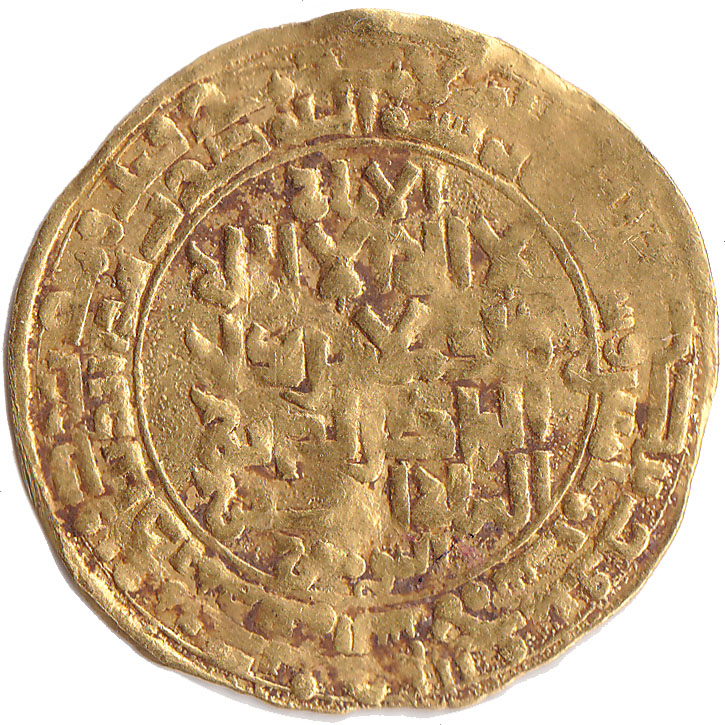Al-Nasir 1180-1225 CE
Gold Abbasid Dinar
Al-Nasir i-Din
Allah (6 August 1158 to 5 October 1225) was the Abbasid Caliph in
Baghdad from 1180 until his death. His laqab can mean literally
The One who Gives Victory to the Religion of God.
He attempted to restore the caliphate to its ancient dominant role,
held Baghdad (the capital of the Abbasid empire), and extended his
dominion into Mesopotamia and Persia.
| SPECIFICATIONS |
| Denomination | Abbasid |
| Metal | Gold Au997 |
| Alloy | Ag%Cu 0.?? |
| Type | Struck |
| Diameter | 30.7 mm |
| Thickness | 0.6 mm |
| Weight | 5.02 gms |
| Shape | Round |
| Edge | Plain |
| Die Axis | 150° |
| Mint | Baghdad |
|

| 
|
Album 268.
Mouse over image to expand.
Click to view higher grade specimens
of AH608 and AH609 from Auction Listings.
|
Obverse : "Al-Imam", kalima and "al-Nasir li-din Allah,
commander of the faithful" in five lines across field;
mint and date formula in inner margin;
Qur'an XXX, 3-4 in outer margin
Reverse : Continuation of kalima and "salla Allah alaihi"
in four lines across field; Qur'an IX, 33 in outer margin.
Steve Album said Abbasid dinar of al-Nasir, Madinat al-Salam mint (Baghdad), dated AH605,
A common type often found in India, occasionally in Sri Lanka
Ceylon Coins and Currency By Codrington (p.158) records
Abbasid of Al-Nasir A.H. 575-622 Baghdad. AH610
The Abbassid of Al-Nasir AH605 AH shown here is from circulation in Lanka.
Most coins of this type don't have a plain inner circle on obverse. I noticed only one
in acsearch
Is this a variety od A-268?
The Abbasid
Caliphate, the third in the Islamic Empire, was founded by the
descendant of the Prophet's youngest uncle, Abbas ibn Abd al-Muttalib.
Created in Harran in 750 CE and shifted its capital in 762 to Baghdad.
The Dynasty improved the appearance of coins using a more elegant form
of Kufic script and the legends and the size of the legends on the
dinars were changed so that they could include two margins.
Towards the end of the Abbasid reign 1160 to 1258CE a series of poorly
struck, light weight coins were issued in Baghdad without any definite
monetary standard.
The weight of type varies randomly from less than 2g to nearly 20g.
In 1258 the Mongol conqueror Hulagu Khan, sacked Baghdad.
In 1261 CE the Calipate resumed in Mamluk Egypt till 1519 when power
was formally transferred to the Ottomans and the capital transferred
to Istanbul.
All of the Gold Islamic coins listed in Codrington's 1914 Catalog of
the Colombo National Museum collection is of the range AH558-683 or
1156 to 1284 CE. This is the height of the Pollonnaruwa Era from
Parakrama Bahu the Great to the Pandyan Invasion during which most of
the massa coins with the rulers name was issued. The AH605 (1208 CE)
coin above is also of this Era during the reign of King DharmasokaDeva.
The oldest Ceylon coin with a date is the Portuguese Tanga
coin of 1631 CE.
The earliest Christian Era dated
coin
is: MCCXXXIIII (1234 CE) Bishop of Roskilde coins, Denmark (six known).
However Islamic dated Arab-Sassanian coins
from AH 1st century ~650CE are known.
The brief description is from a Auction
listing of AH609 coin
I am interested in writing up this coin with detailed description with
all the Arabic Text on the coin in unicode with their transliterations
and translations. Would be grateful to anyone who can give me a
reference if it has been published, or help me do it using images of
this type of coin where the Arabic text is clear.
Please E-mail me at kavanr @ gmail.com if you can help.
The coin was scanned at 600 dpi and displayed at 254 dpi.
It was purchased in Sri Lanka 2021 March from a dealer in Bandaragama.

